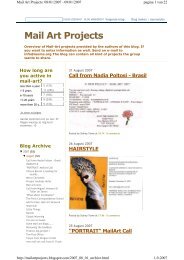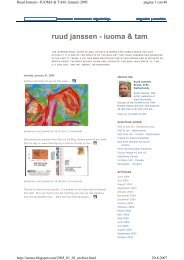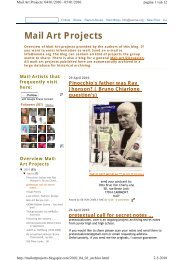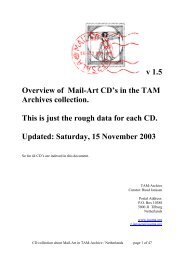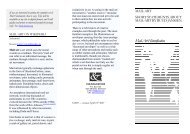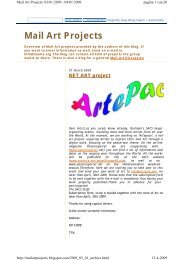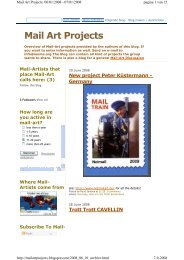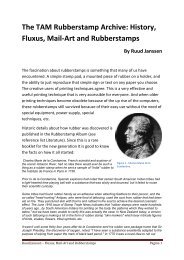Géza Perneczky - Ruud Janssen
Géza Perneczky - Ruud Janssen
Géza Perneczky - Ruud Janssen
Create successful ePaper yourself
Turn your PDF publications into a flip-book with our unique Google optimized e-Paper software.
6. That works of art/poetry strive for autonomy. (...)<br />
7. That art/poetry strives for origoinality/“modernity“. (...)<br />
8. That art/poetry strives towards the „primeval“. (...)<br />
This contrtadicts 7, though both are modernist positions.<br />
9. That poetry is verbal alchemy. (...)<br />
10. That poetry is verbaé chemistry, or biology, etc. (...)<br />
All these positions have in turn liberated language arts from certain constraints, and<br />
have led to the exploration of other areas. (...) Non-mimesis is perhaps a necessary<br />
but non-sufficient pre-condition of autonomy. Autonomy oftenleadsto a new mimesis.<br />
This is why the cycle of figurative to non-figurative and back is so often repeated<br />
in the history of art... (From the „foreword“ to a forthcoming collection of facts<br />
about, statements on, and examples of, concrete visual and sound poetry, assembled<br />
by Bob Cobbing & Peter → Mayer)»<br />
(Bob Cobbing / Peter Mayer. In: Kontexts, #5 [→ Gibbs]. Devon, 1972. n. p.)<br />
Cohen, Ryosuke 3-76-1-A-613. Yagumokitacho Moriguchi City, Osaka, 570 Japan 1988<br />
↑ 1-6 Hiyochico Moriguhi-City, Osaka, 570 - “ - 1984<br />
.............................................................................................................................................................<br />
^Osaka Int. Mail Art Exh. (Mail Art Campaign in Japan), Doc.: Poster of <br />
60x40 cm., offset. Osaka New Art Center, September 10-15, 1984<br />
Mail Art Network for the Children of the World. Doc.: Poster of 53x41 cm., <br />
offset, r/v. Exh.: Kyoto City Art Museum, July 9-14, 1985<br />
^Brain Cell (Stamp-sticker-graphic assembling, one A/3 page {150}. Silk screen<br />
techn. + collages. The single sheets put into an envelope and sent out<br />
by the editor to the contributors form the numbered issues. Each 20<br />
issues (e.i. #220-240) constructs a cycle, which can be laid together<br />
and presented as an album like assembling {50 from the 150}. The<br />
issues are completed by separeted contributor lists. 1985-, 25-30xy.,<br />
~ 550#)<br />
^# Beside a number of div. singel issues also the cicles: #1-20, 21-40,<br />
81-100, 261-280, 361-380<br />
~<br />
Literature:<br />
(Editor's Statement, 1985): «...It isn't everything that exchange a work from one to<br />
another in mail art network. It is the most important to join much more people of<br />
other countries. Sending to B from A, to C from B, to D or E from C, E sends back<br />
to A or D sends back to B or C.This is the way to spread the network. Once, people<br />
belived that art is the product of the privileged classes called artists, so they put up<br />
the framed pictures or priced them unreasonably as sales contracts. In their reasons<br />
they think art is material. I think art is information. The personality and creative<br />
power of all the persons who follow it spread as information. There is no need for<br />
us to stress our own individuality. It is a change of 180 degrees from the past. Mail<br />
Art network is the most wonderful movement that can solve the various problems<br />
of present art and artists: authority, exchange of information, too national art,<br />
mistaken holiness and so on. (...) Well, I'll title my work Brain Cell, because the<br />
structure of a brain through a microscope looks like the diagram of mail art network.<br />
Thousands of neurons clung and piled up together are just like mail art network,<br />
I think.» (Qoted in: Stephen → Perkins: Assembling Magazines. Internationale<br />
Networking Collaborations. Cat.: Half-legal, phc., 64 p. Subspace, Iowa City. 1996<br />
/ Print: 1997. 15 p.)<br />
«By the time a person is six year old, her or his brain size is 90% of what it ever<br />
will be. (Sort of scary, isn't it?) Ryosuke Cohen's network of stamp/mail artists is<br />
known as „Brain Cell“. This group of neurons results in a rainbowed lithographic<br />
package intertwinning each thought and stamp image that Cohen receives. Send a<br />
rubber stamp image to Ryosuke Cohen...» (Lightworks [→ Burch], Glimmerings<br />
[Print Review], N° 18, Winter 1986-87, 48 p.)




